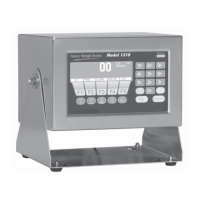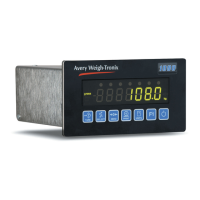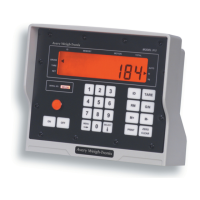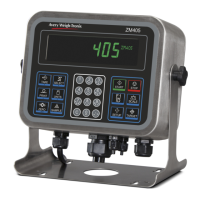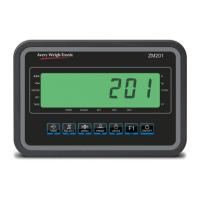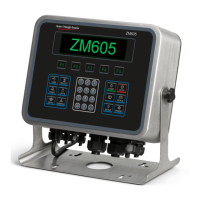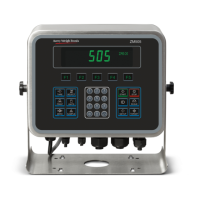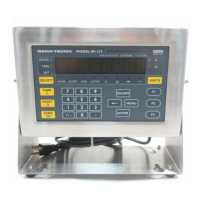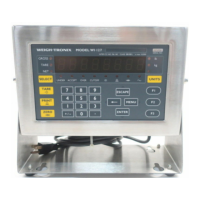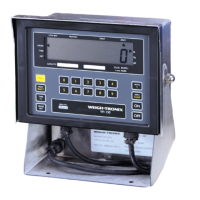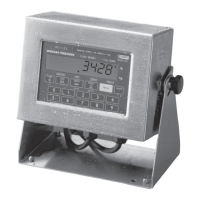Do you have a question about the Avery Weigh-Tronix 2060 and is the answer not in the manual?
Details about manual structure, text conventions, and hazard alert symbols.
Covers installation guidelines and safe handling of batteries with warnings.
Procedures for regular maintenance, cleaning, and necessary training.
Information on FCC/EMC compliance, Declaration of Conformity, and handling precautions.
Description of the front panel layout, including keys and display.
Details of the main display, contrast adjustment, keypad use, and menu access.
Examples and descriptions of the 10 available print formats.
Instructions on mounting the indicator using V or Ram mounts.
Details on voltage requirements and cable connections.
Detailed pinouts and descriptions for various connectors.
Guidance on properly routing the scale interface cable.
Instructions for connecting the indicator to an auxiliary power outlet strip.
Procedures for connecting the indicator to a DC power source or battery.
Procedures for wiring to 12V, 24V, and grounded power systems.
Instructions for connecting the indicator using an AC to DC power converter.
How to connect peripheral devices using serial communication ports.
Detailed pinout and wire color guide for the 9-pin I/O connector.
Standard calibration using configuration numbers and weigh bar labels.
Tables for configuration codes and lists for common applications.
Process for custom configuration using AWTX weigh bars.
Methods for finding, entering, and calibrating with custom numbers.
Method for calibrating using custom numbers, including verification.
How to configure the indicator for non-Avery Weigh-Tronix weigh bars.
How to access, navigate, and exit menus using passwords.
Details on User, About, and Audit submenus for settings and information.
Overview of diagnostics and specific tests for Scale and Current Zero.
Testing display, buttons, ports, and inputs for proper function.
Testing outputs, viewing options, and managing overload/underload logs.
Accessing Setup, Diag, User, and Audit menus via Admin password.
Overview of Setup menu items: Ports, Calib, Scale.
Setting the zero point for the scale using various methods.
Calibrating the scale span by entering test weight values.
Procedures for linearity, incremental calibration, and key-in calibration.
Procedures for gravity adjustment, viewing calibration weight, and setting calibration units.
Procedures for printing reports, entering configuration numbers, and adjusting span.
Configuring scale parameters like capacity, division size, and units of measure.
Setting scale stability, auto-zero tracking, and vibration filtering parameters.
Configuring capacity ranges, zero bands, and dual/triple ranging operations.
Selecting scale operating modes and Rate of Change parameters.
Selecting the area of operation to set default parameters.
Setting display parameters like decimal separator and refresh rate.
Configuring front panel keys and displayable values during weighing.
Setting tare entry types and printing configuration data or resetting defaults.
Configuring transaction archives, serial numbers, and software updates.
Managing passwords, zero lock, beeper, and scale number settings.
Overview of port configuration and detailed serial port settings.
Setting IP address, subnet, gateway, and DHCP for the Ethernet port.
Configuring connection types (Off, Client, Server, UDP) for Ethernet ports.
Configuring communication protocols (e.g., ENQ, SMA, PLC, FTP, RD) and their attributes.
Details on protocol attributes (Attr x) and bindings (Port, Enet, File) for communication.
Editing print formats and configuring Ethernet settings for PLC communication.
Configuring inbound data mapping for PLC communication, including data types.
Setting up printers, including brand selection and port binding.
Choosing file save location (USB, SD Card) and naming conventions.
Enabling and configuring option cards and USB settings.
Configuring expansion RS232 cards.
Accessing application-specific functions like Auto Settings, Totals, App Settings, and App Info.
Steps to enter the Application menu using password 1793.
Configuring livestock weighing features like Auto-Loc and Auto-Acc.
Managing accumulation totals, including printing and clearing.
Configuring application-specific settings like alarm types and default tare weights.
Viewing current versions of bootloader, firmware, application, LUA, and SQLite.
Details about manual structure, text conventions, and hazard alert symbols.
Covers installation guidelines and safe handling of batteries with warnings.
Procedures for regular maintenance, cleaning, and necessary training.
Information on FCC/EMC compliance, Declaration of Conformity, and handling precautions.
Description of the front panel layout, including keys and display.
Details of the main display, contrast adjustment, keypad use, and menu access.
Examples and descriptions of the 10 available print formats.
Instructions on mounting the indicator using V or Ram mounts.
Details on voltage requirements and cable connections.
Detailed pinouts and descriptions for various connectors.
Guidance on properly routing the scale interface cable.
Instructions for connecting the indicator to an auxiliary power outlet strip.
Procedures for connecting the indicator to a DC power source or battery.
Procedures for wiring to 12V, 24V, and grounded power systems.
Instructions for connecting the indicator using an AC to DC power converter.
How to connect peripheral devices using serial communication ports.
Detailed pinout and wire color guide for the 9-pin I/O connector.
Standard calibration using configuration numbers and weigh bar labels.
Tables for configuration codes and lists for common applications.
Process for custom configuration using AWTX weigh bars.
Methods for finding, entering, and calibrating with custom numbers.
Method for calibrating using custom numbers, including verification.
How to configure the indicator for non-Avery Weigh-Tronix weigh bars.
How to access, navigate, and exit menus using passwords.
Details on User, About, and Audit submenus for settings and information.
Overview of diagnostics and specific tests for Scale and Current Zero.
Testing display, buttons, ports, and inputs for proper function.
Testing outputs, viewing options, and managing overload/underload logs.
Accessing Setup, Diag, User, and Audit menus via Admin password.
Overview of Setup menu items: Ports, Calib, Scale.
Setting the zero point for the scale using various methods.
Calibrating the scale span by entering test weight values.
Procedures for linearity, incremental calibration, and key-in calibration.
Procedures for gravity adjustment, viewing calibration weight, and setting calibration units.
Procedures for printing reports, entering configuration numbers, and adjusting span.
Configuring scale parameters like capacity, division size, and units of measure.
Setting scale stability, auto-zero tracking, and vibration filtering parameters.
Configuring capacity ranges, zero bands, and dual/triple ranging operations.
Selecting scale operating modes and Rate of Change parameters.
Selecting the area of operation to set default parameters.
Setting display parameters like decimal separator and refresh rate.
Configuring front panel keys and displayable values during weighing.
Setting tare entry types and printing configuration data or resetting defaults.
Configuring transaction archives, serial numbers, and software updates.
Managing passwords, zero lock, beeper, and scale number settings.
Overview of port configuration and detailed serial port settings.
Setting IP address, subnet, gateway, and DHCP for the Ethernet port.
Configuring connection types (Off, Client, Server, UDP) for Ethernet ports.
Configuring communication protocols (e.g., ENQ, SMA, PLC, FTP, RD) and their attributes.
Details on protocol attributes (Attr x) and bindings (Port, Enet, File) for communication.
Editing print formats and configuring Ethernet settings for PLC communication.
Configuring inbound data mapping for PLC communication, including data types.
Setting up printers, including brand selection and port binding.
Choosing file save location (USB, SD Card) and naming conventions.
Enabling and configuring option cards and USB settings.
Configuring expansion RS232 cards.
Accessing application-specific functions like Auto Settings, Totals, App Settings, and App Info.
Steps to enter the Application menu using password 1793.
Configuring livestock weighing features like Auto-Loc and Auto-Acc.
Managing accumulation totals, including printing and clearing.
Configuring application-specific settings like alarm types and default tare weights.
Viewing current versions of bootloader, firmware, application, LUA, and SQLite.
| Brand | Avery Weigh-Tronix |
|---|---|
| Model | 2060 |
| Category | Accessories |
| Language | English |
